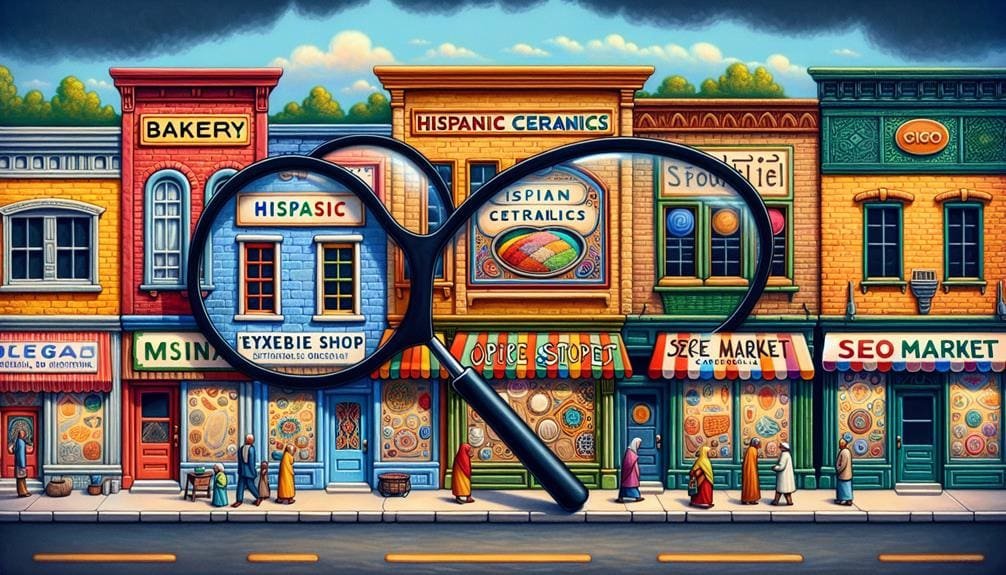Maximizing Title Tags for Neighborhood Shops
January 14, 2024 | by Jacob Cavazos

Recent studies suggest that nearly half of all Google searches have a local intent, indicating that many potential customers are looking for shops and services in their immediate vicinity. We understand the critical role that well-crafted title tags play in capturing this local market—these snippets influence search engine rankings and affect click-through rates. In our quest to help neighborhood shops thrive, we’ve honed in on strategies that include seamlessly integrating location-based keywords with brand and service descriptors, striking a balance between relevance and appeal. By prioritizing mobile optimization, we ensure these tags catch the eye of the ever-growing number of users searching on the go. As we explore the nuances of effective title tag creation, remember that each word counts towards making that vital first impression on potential customers who are just a stone’s throw away. Stay tuned as we unveil the tools and insights to transform casual searches into foot traffic for your local business.
Understanding Local SEO Significance
To tap into the local market effectively, we must grasp the significance of local SEO, as it directly impacts our ability to show up in search results for potential customers in our area. By honing in on the nuances of search engine optimization targeted at local search results, we can elevate our visibility and connect with the community our business serves.
When we optimize our title tags with Tags for Local SEO, we’re crafting a unique title that includes important keywords and the location of our business. This strategic move helps search engines understand the relevance and context of our pages, which is a decisive factor in ranking within local search engine results pages (SERPs). The goal is to rank higher, making our shop a choice for nearby consumers.
Our mastery is demonstrated through the precision with which we optimize your title tags, ensuring they’re accurate and compelling. A title tag is a first impression – it needs to grab attention and inform. We make every character count, balancing readability and keyword inclusion. This balance will drive click-through rates and foot traffic to our door.
Crafting Location-Specific Title Tags

Crafting location-specific title tags, we strategically incorporate the primary city or neighborhood alongside relevant keywords, ensuring our neighborhood shop surfaces in searches by local customers. This targeted approach is crucial for optimizing title tags to connect with the community and boost click-through rates.
Here’s how we refine our strategy:
- Conduct Keyword Research: We identify high-search volume keywords tailored to our locale, ensuring we’re tapping into actual search patterns within our community.
- Optimize Title Tag Length: Keeping title tags under 60 characters ensures our homepage title isn’t cut off when displayed in search, maximizing visibility and impact.
- Incorporate Unique Selling Points: We include what sets our local shops apart within our title tags, making them irresistible to potential customers.
- Test and Analyze: By monitoring click-through rates, we can iterate on our title tags, refining them to meet the needs of our audience better.
We’ve learned that precision and local relevance are critical to writing a title tag that drives traffic. Every word counts, and with continuous optimization, we’re creating tags that rank and resonate with our community.
Incorporating Brand and Service Keywords

Building on our foundation of location-specific title tags, we now focus on weaving in brand and service keywords to sharpen our shop’s local search presence and attract more targeted traffic. Incorporating our brand name alongside our primary keyword within title tags is crucial. Title tags are one of the most essential elements in creating a title for the title of a web page. They signal to search engines what our page is about, helping to rank our shop higher in search results.
Every page on our website should include a unique title tag that blends our brand with our services. This approach reinforces our identity and clarifies the page’s content for search engines and potential customers alike. We know from data-driven SEO strategies that the strategic placement of these keywords can significantly impact our visibility in local search queries.
When creating a title tag, it’s essential to put the most important keywords at the beginning. This prominence ensures that both search engines and users immediately understand the unique offerings of our neighborhood shop. By mastering these tactics, we set ourselves apart from the competition and cement our local authority, driving high-intent traffic directly to our doorstep.
Enhancing Click-Through Rates With Action Words

Infusing title tags with action words like ‘Discover,’ ‘Explore,’ and ‘Unlock’ can boost click-through rates by sparking curiosity and prompting user engagement. As we delve into maximizing title tags for neighborhood shops, it’s essential to understand that a good title is more than a label—it’s a strategic tool. Enhancing click-through rates isn’t just about visibility; it’s about enticing potential customers to take the next step.
Here’s how we can apply this knowledge:
- Incorporate Action Words: Integrate compelling verbs into your title tags to create a sense of excitement and urgency.
- Focus on Relevance: Ensure the action words align with your shop’s offerings—misleading titles can harm search ranking.
- Test and Refine: Use A/B testing to determine which action words resonate best with your target audience.
- Keep It Fresh: Regularly update your title tags with new action words to maintain engagement and avoid ad fatigue.
Avoiding Common Title Tag Pitfalls

While incorporating action words in title tags can captivate audiences, it’s equally crucial to sidestep common mistakes that could dilute their effectiveness. We must avoid keyword stuffing, which can negatively impact a web page’s ranking. Instead, we aim for the perfect title that balances relevance and readability for those trying to rank in local search results.
As we craft title tags, we ensure they’re precisely tailored to our neighborhood shop’s offerings. Remember, tags are HTML elements that serve as a first impression on search engines and potential customers. Our focus remains on relevance and clarity, ensuring we align with Google’s Ranking Factors.
To provide a deeper understanding, here’s a table highlighting common title tag pitfalls and how to avoid them:
| Pitfall | Consequence | Solution |
|---|---|---|
| Keyword Stuffing | Lowers rankings | Use primary & secondary keywords judiciously |
| Generic Terms | Misses target audience | Include specific details & location |
| Neglecting Keywords | Poor visibility | Research & use relevant keywords |
| Mismatched Titles | Confuses users | Align title with web page content |
| Excessive Length | Gets cut off on SERPs | Keep within 50-60 characters |
Frequently Asked Questions
How Do You Optimize Title Tags?
We optimize title tags by ensuring title length is concise, strategically placing keywords, including our brand, adding unique descriptors, considering search volume, and aligning with user intent to boost click-through rates and match meta descriptions.
What Is a Bad Strategy When Creating Quality Title Tags?
We avoid overstuffing keywords, irrelevant phrases, and creating vague descriptions. Ignoring branding, missing location info, duplicate titles, excessive length, non-descriptive text, caps lock overuse, and unique character chaos are strategies we know to steer clear of.
What Makes a Good Title Tag?
We’ve found that a reasonable title tag incorporates keyword research, reflects branding essentials, and stays within character limits, ensuring unique descriptions and click enticement while resonating with consumer language and local search patterns.
How Do I Make My Title SEO Friendly?
To make our title SEO-friendly, we’ll research keywords, including our brand, use local modifiers, align with search intent, optimize for mobile, and ensure a reasonable click-through rate with proper title length and unique descriptors.
RELATED POSTS
View all



